Gendarmery (Serbia)
The Gendarmery (Serbian Cyrillic: Жандармерија) is an armed police force of the Serbian police. It was formed on 28 June 2001, after the disbandment of the Special Police Units (PJP). Gendarmery in Serbia existed in previous form from 1860 to 1920. As a special unit inside Serbian police, its role can be compared to those of Russian OMON and former Ukrainian Berkut units.
| Gendarmery Жандармерија Žandarmerija | |
|---|---|
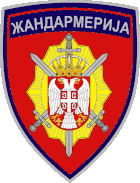 Gendarmery badge | |
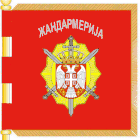 Gendarmery flag | |
| Agency overview | |
| Formed | 28 June 1860 (current form since 2001) |
| Preceding agency | |
| Employees | 3,734 (2012)[1] |
| Jurisdictional structure | |
| National agency | Serbia |
| Operations jurisdiction | Serbia |
| Governing body | Government of Serbia |
| Operational structure | |
| Overviewed by | Ministry of Internal Affairs |
| Headquarters | Belgrade |
| Elected minister responsible | |
| Agency executive |
|
| Website | |
| Official website | |
As of 2017, Gendarmery consists of about 2,800 members. The Command of the Gendarmery is in Belgrade.[2]
The gendarmery's duties are both civilian and military, including securing the 'Ground Safety Zone'[3] along the administrative line with Kosovo and providing disaster rescue teams (see below).[4]
History
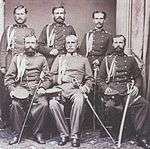
The word žandarmerija is a French loanword ("gendarmerie"), and is pronounced "zhandarmeriya". The Žandarmerija corps date back to the Principality of Serbia, established on June 28, 1860, and originally consisted of 120 officers. It was disbanded after World War II and was restored in 2001 by the reorganization of the irregular "Special Police Unit" (Posebna Jedinica Policije, PJP).[2] This was accomplished by an act issued by the Minister of Interior Dušan Mihajlović. One of its first major assignments was capturing the suspects in the assassination of prime minister Zoran Đinđić.
On 7 May 2003, the Counter-Terrorist Unit (CTU) was established within Gendarmery, but was separated in April 2007 to become an independent unit within the Police.[5]
In 2005 the Person and Infrastructure Protection Unit was established, to carry out close protection tasks, as well as activities related to technical protection.[5][2]
In 2011 the Gendarmery was reorganized and the First Quick Response Detachment was established, consisting of the specialist companies of all Gendarmery detachments along with the Diving Center.[5]
Commanders
Since its establishment, the Serbian Gendarmery has had six Commanders:[2][6]
| No. | Commander | Took office | Left office | Time in office | Minister of Internal Affairs | |
|---|---|---|---|---|---|---|
| 1 | Colonel Goran Radosavljević (born 1957) | 28 June 2001 | 17 August 2004 | 3 years, 50 days | Dušan Mihajlović Dragan Jočić | |
| 2 | Colonel Borivoje Tešić (born 1956) | 17 August 2004 | 23 June 2008 | 3 years, 311 days | Dragan Jočić | |
| - | Colonel Srđan Grekulović (born 1962) Acting | 23 June 2008 | 3 June 2009 | 345 days | Dragan Jočić Ivica Dačić | |
| 3 | Colonel Bratislav Dikić (born 1970) | 3 June 2009 | 17 July 2013 | 4 years, 44 days | Ivica Dačić | |
| - | Colonel Milenko Božović (born 1965) Acting | 17 July 2013 | 2 August 2013 | 16 days | Ivica Dačić | |
| 4 | Colonel Milenko Božović (born 1965) | 2 August 2013 | 13 March 2015 | 1 year, 223 days | Ivica Dačić Nebojša Stefanović | |
| 5 | Colonel Goran Dragović (born 1967) | 13 March 2015 | 2 August 2018 | 3 years, 142 days | Nebojša Stefanović | |
| 6 | Colonel Dejan Luković | 2 August 2018 | Incumbent | 2 years, 15 days | Nebojša Stefanović |
Organization
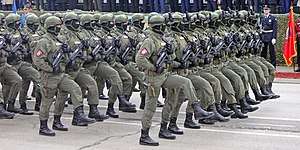
In 2012, the Serbian Gendarmery consisted of about 3,734 members,[7] while in 2017 the strength is estimated at about 2,800 members.[2]
Alongside the operational detachments deployed through Serbia, the Gendarmery has some specialized units: the Diving Unit and the Personnel and Infrastructure Protection Unit, which is specialized in tasks of physical and technical protection.[2]
Detachments
The principal bases are located in Belgrade, Niš, Novi Sad and Kraljevo.[2]
Detachments are organized as independent units in order to be able to execute every-day duties on their territory of jurisdiction. Should the need arise, each detachment may quickly support others throughout Serbia.[2]
First Quick Detachment
Within each operational detachment, a company-sized specialized unit is tasked to deal with most complex tasks in both urban and rural environment. In turn, each specialized unit consists of several counter-terrorist teams, which may be reinforced by sniper, K9 and explosive ordnance disposal assets when needed.[2] Since 2011, specialized units are grouped within the First Quick Detachment.[5] The first commander was Police Lieutenant Colonel Vojkan Ivanovic.[5]
Diving Unit
The Diving Unit of the Serbian Gendarmery is headquartered in Belgrade and is intended for conducting special actions in environments dominated by water, as well as the land area near water.[2] Its operational element consists of three specialist teams: intervention team, searching team and nautical team.[5]
The Diving Unit tracks its origins to 1997, when it was established within the Special Operation Unit.[5]
Mission
Its main duties are:
- Restoring peace and stability if they have been heavily disturbed
- Counter terrorism
- Countering violent groups
- Repressing prison riots
Its civil duties include: to provide security and public peace, to investigate and prevent organized crime, terrorism and other violent groups; to protect state and private property; to help and assist civilians and other emergency forces in a case of emergency, natural disaster, civil unrest and armed conflicts.
Its military duties include to provide, preserve and protect security and public peace, public order, to protect state and private property, to assist other security forces in case of emergency, civil unrest, war; to repress riots; to reinforce martial law and mobilization; to fight and apprehend suspected criminals, terrorists and other violent groups ;
Its additional duties are to perform any duties decreed in the decrees of law and regulations other than civil, military and other duties and the duties given by the governmental decrees based on them.
Equipment
Firearms
| Name | Country | Caliber | Notes |
|---|---|---|---|
| CZ 99 | Serbia | 9×19 Parabellum | In use also CZ999 |
| Glock 17 | Austria | 9×19 Parabellum | In use Glock 17 Gen 3 |
| SIG Sauer P 220 | Switzerland | 9×19 Parabellum | |
| Amadeo Rossi | Brasil | 357. Magnum | For training purposes |
| Smith&Wesson | U.S. | 357. Magnum | For training purposes |
| Zastava R83 | Serbia | 357. Magnum | For training purposes |
| HK MP5 | Germany | 9×19 Parabellum | In use A2,A3,SD3,K versions |
| Zastava M92 | Serbia | 7.62×39 | |
| Zastava M84 Škorpion | Yugoslavia | 7.65×17 | Personal Defense Weapon |
| Zastava M70 | Yugoslavia/Serbia | 7.62×39 | In use AB1,AB2 and modernised ABX versions |
| Zastava M21 | Serbia | 5.56×45 NATO | |
| MPi-KM | East Germany | 7.62×39 | |
| Colt M4 | U.S. | 5.56×45 NATO | A4 Commando version in use |
| Zastava M76 | Yugoslavia | 7.92×57 | |
| Zastava M91 | Serbia | 7.62×54R | |
| Steyr | Austria | 7.62×51 NATO | Tactical Elite |
| HK G3 | Germany | 7.62×51 NATO | |
| HK G33 | Germany | 5.56×45 NATO | |
| SIG Sauer 716 | Switzerland | 7.62×51 NATO | |
| Zastava M93 | Serbia | 12.7×108 | |
| Barrett M82 | U.S. | 12.7×99 NATO | |
| Barrett M95 | U.S. | 12.7×99 NATO | Bullpup sniper rifle |
| Zastava M84 | Yugoslavia/Serbia | 7.62×54R | |
| Browning M2 | U.S. | 12.7×99 NATO | Mounted only on vehicles |
| Zastava M93 | Serbia | 30mm | Automatic granade launcher |
Vehicles
| Model | Image | Origin | Type | Variant | Number | Details | |
|---|---|---|---|---|---|---|---|
| BOV | 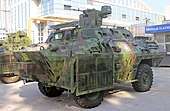 | Armored personal carrier | BOV M15 | 20 | Armed with 12.7mm RWS | ||
| BOV | 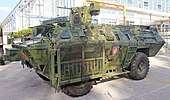 | Armored personal carrier | BOV M11 | 20 | Armed with 12.7mm RWS | ||
| BOV | 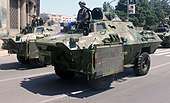 | Armored personal carrier | BOV M86 | 20 | Armed with 14.5mm KPVT heavy machine gun | ||
| BOV | 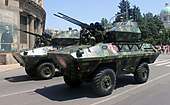 | anti-aircraft | BOV-3 | SPAAG with triple M55A4B1 20mm cannon | |||
| BOV M16 |  | Armoured multi-purpose combat vehicle | BOV M16 Miloš | Armed with 12.7mm RWS | |||
| Lazar armored vehicle | 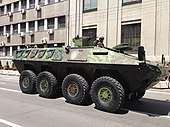 | Armored personal carrier | Lazar-3 | 12 | Armed with 12.7mm RWS | ||
| Saxon |  | Armored personal carrier | AT105 Saxon | 1 | Armed with 12.7mm Zastava M02 Coyote | ||
| Praga | 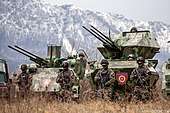 | Anti-aircraft | M53/59 Praga | 3 | Armed with 30 mm twin AA autocannon | ||
| SPAT 30/2 |  | Anti-aircraft | SPAT 30/2 | 4 | Self-propelled anti-aircraft gun 2x30mm Foka based on BVP M-80 hull | ||
| AIFV | 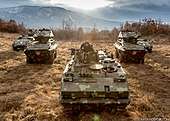 | Infantry fighting vehicle | YPR-765 | 1 | YPR-765 seized from Dutch UN peacekeepers in the Bosnian War | ||
| TAM |  | Riot control vehicle | TAM 110 | Riot trucks | |||
| TAM |  | Armoured personnel carrier | TAM 110 | Ris armored truck | |||
| TAM |  | Military truck | TAM 150 | T11 truck | |||
| Humvee |  | All-wheel-drive vehicle | HMMWV | American-made Hummers procured via Cyprus used by former Special Operations Unit | |||
| Land Rover | 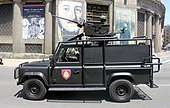 | All-wheel-drive vehicle | Land Rover Defender | ||||
| Sevel |  | Fiat Ducato | |||||
| Yamaha | 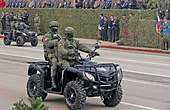 | ATV | Kodiak 700 | ||||
| Toyota |  | Toyota Land Cruiser | |||||
| Škoda |  | Škoda Rapid | |||||
See also
- Law enforcement in Serbia
References
- "Novi odred Žandarmerije sličan JSO". b92.net (in Serbian). 24 January 2012. Retrieved 4 December 2017.
- Jevtic, Milos (13 January 2017). "Serbian Gendarmerie". Spec Ops Magazine. Retrieved 10 July 2018.
- B92. "Interior minister in Ground Safety Zone". www.b92.net. Retrieved 26 August 2014.
- "Nadležnosti" [Duties]. Ministry of the Interior, Republic of Serbia (in Serbian). Archived from the original on 9 February 2016. Retrieved 24 January 2018.
- "Gendarmerie of the Republic of Serbia". specijalne-jedinice.com. Retrieved 10 July 2018.
- "Serbian ministries, etc". rulers.org. B. Schemmel. Retrieved 14 August 2018.
- "Novi odred Žandarmerije sličan JSO" (in Serbian). B92. 24 January 2012. Retrieved 3 August 2013.
External links
| Wikimedia Commons has media related to Gendarmerie (Serbia). |
- Official Žandarmerija of the Ministry of Internal Affairs
- Short video about Žandarmerija
- "Nadležnosti" [Duties]. Ministry of the Interior, Republic of Serbia (in Serbian)

